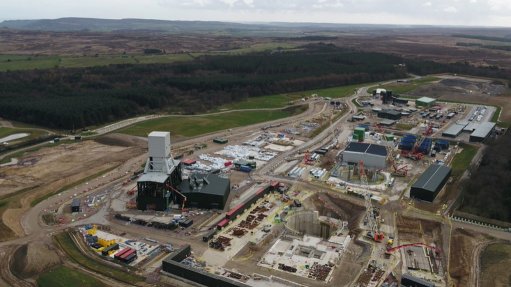Private sector helps provide acceptable air quality
Amid ongoing loadshedding, members of the private sector are looking for ways to improve air quality during working hours, owing to higher emissions being released as a result of State-owned utility Eskom burning coal at an unprecedented rate.
According to the Centre for Research on Energy and Clean Air, Eskom’s emissions from the national power plants are expected to be responsible for 79 500 air pollution-related deaths between 2025 until the plants’ planned end-of-life.
Additionally, other avoidable health implications include 140 000 asthma emergency room visits, 5 900 new cases of childhood asthma, 57 000 premature births, 35-million days of missed work and 50 000 years lived with disability.
“Given government’s inability to address air pollution in the immediate future and no clear signs of an end to coal powered energy generation, it’s up to South Africans to take control of the air they breathe.
“While we wait for government to take a more sustainable approach to air quality, the private sector can take action within our workspaces,” says heating, ventilation and air-conditioning (HVAC) systems services company SFI Group MD Edward Hector.
He warns that buildings can also add to air quality challenges, highlighting that a slight increase in ventilation rates is not adequate to address the issues at hand.
“In many cases the air conditioning system and ductwork aren’t properly maintained and cleaned, with viruses, bacteria and mould building up over time. “Some reports show that 65% of ducts are contaminated, with 10% [being] infected with pathogenic bacteria.
“Even clean ducts can’t address the many chemical agents being circulated indoors coming from perfumes, aerosols, cleaning products and even airborne fibreglass particles. “Considering we spend 90% of our time in indoor spaces, that’s six to eight hours a day breathing in an unknown amount of chemicals and pathogens,” he explains.
Technologies Available
With the Covid-19 pandemic highlighting the importance of indoor air quality, advances in air purification technology ensure that improving air quality is cost-effective while reducing exposure to various airborne diseases.
Hector highlights two technologies that have gained popularity in this regard.
Firstly, photocatalytic oxidation (PCO) air purifier devices are installed inside the air handling unit or duct to purify air as it flows through the entire ventilation system.
PCO is a chemical effect produced when a light source penetrates a surface that works as a semiconductor material of photocatalyst.
The photocatalyst absorbs the ultraviolet light and creates oxygen particles, owing to a mix of metals including titanium dioxide.
Secondly, Ultraviolet-C radiation (UVC) light fixtures are also an effective way to inactivate viruses in a building’s air handling system.
Retrofitting UVC in a building can help keep occupants safe and healthy while being cost-effective. UVC products are specifically engineered for retrofitting into existing air handling units and swab tests are conducted before and after installation to demonstrate the efficacy of reducing any microbial count.
“When installed in an HVAC system, UVC is effective in inactivating pathogens such as Covid-19, Influenza A and B, Staph, Legionella and Tuberculosis. Improving the air quality helps businesses reduce sick days and boost productivity.
“It also improves HVAC efficiencies by improving heat exchange and airflow, and reducing energy consumption by as much as 20%. Building managers are keen on the technology because they can achieve measurable return on investment within just one to three years,” Hector shares.
Healthy Buildings
To protect workers from pollution and illness, Hector notes that five steps can be taken to improve indoor air quality.
Firstly, owing to indoor air quality being dynamic, starting with measuring key metrics will allow for a better understanding of factors such as occupancy levels and outdoor ambient conditions.
Secondly, build the data into meaningful dashboards to educate occupants on where things stand and to get their buy-in for the benefits they can enjoy once the work is done.
Thirdly, pilot air purification products from reputable sources. Poor installations will result in suboptimal results.
Fourth, focus on interventions that involve HVAC systems instead of standalone technologies. It could be the HVAC system that is the source of the problem.
Finally, do not view these interventions simply as a cost. The upside of a healthy building includes lower absenteeism, and higher productivity and energy savings, all of which are attractive to current and future tenants.
Hector adds that air quality measurement may be a victim of loadshedding with increased blackouts resulting in monitoring stations being offline and the South African Weather Service failing to make its quality monitoring goals for the last quarter.
“The future of our grid might be uncertain, but there are proactive measures the private sector can take to ensure our workers are at least breathing clean, safe air. Fortunately the technologies that deliver the best quality air also deliver some real business benefits, so the choice should not be a difficult one,” he concludes.
Comments
Press Office
Announcements
What's On
Subscribe to improve your user experience...
Option 1 (equivalent of R125 a month):
Receive a weekly copy of Creamer Media's Engineering News & Mining Weekly magazine
(print copy for those in South Africa and e-magazine for those outside of South Africa)
Receive daily email newsletters
Access to full search results
Access archive of magazine back copies
Access to Projects in Progress
Access to ONE Research Report of your choice in PDF format
Option 2 (equivalent of R375 a month):
All benefits from Option 1
PLUS
Access to Creamer Media's Research Channel Africa for ALL Research Reports, in PDF format, on various industrial and mining sectors
including Electricity; Water; Energy Transition; Hydrogen; Roads, Rail and Ports; Coal; Gold; Platinum; Battery Metals; etc.
Already a subscriber?
Forgotten your password?
Receive weekly copy of Creamer Media's Engineering News & Mining Weekly magazine (print copy for those in South Africa and e-magazine for those outside of South Africa)
➕
Recieve daily email newsletters
➕
Access to full search results
➕
Access archive of magazine back copies
➕
Access to Projects in Progress
➕
Access to ONE Research Report of your choice in PDF format
RESEARCH CHANNEL AFRICA
R4500 (equivalent of R375 a month)
SUBSCRIBEAll benefits from Option 1
➕
Access to Creamer Media's Research Channel Africa for ALL Research Reports on various industrial and mining sectors, in PDF format, including on:
Electricity
➕
Water
➕
Energy Transition
➕
Hydrogen
➕
Roads, Rail and Ports
➕
Coal
➕
Gold
➕
Platinum
➕
Battery Metals
➕
etc.
Receive all benefits from Option 1 or Option 2 delivered to numerous people at your company
➕
Multiple User names and Passwords for simultaneous log-ins
➕
Intranet integration access to all in your organisation


















